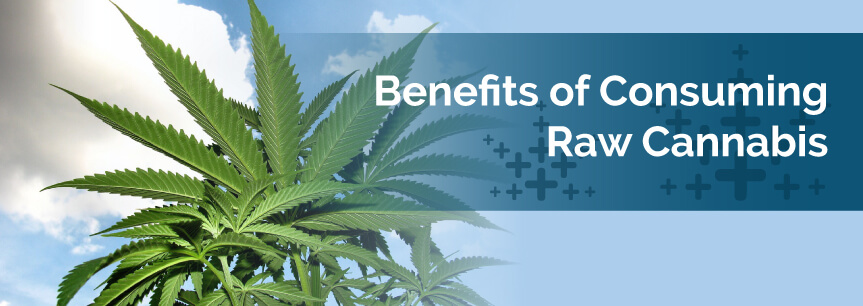
Juicing leafy greens like spinach and kale for their healthy properties might not sound that amazing to you unless you’re a juicing enthusiast. But pressed vegetable juices are increasing in popularity — with consumers, nutritionists, athletes and healthcare professionals.
Have you ever considered juicing marijuana, though? What we’re talking about here is the juicing of raw cannabis, and it’s nutritionally complete and very therapeutic — not to mention, since it’s freshly harvested and not dried or cured, it won’t get you stoned.
The marijuana plant’s leaves are rich in properties such as antioxidants, polyphenols and antibiotics as well as cancer-reducing and anti-inflammatory compounds known as cannabidiols. These compounds are what makes raw weed a superfood.
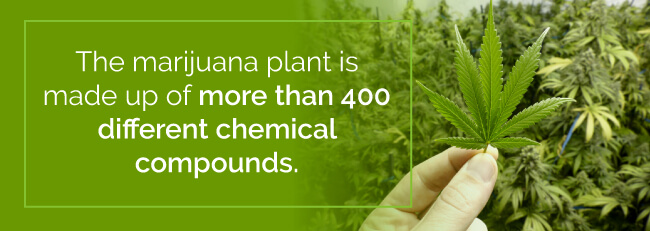
In fact, the marijuana plant is made up of more than 400 different chemical compounds. Because of the number of acids, vitamins and essential oils in the plant, experts like Dr. William Courtney, who provides patients with raw marijuana therapeutic services in his Luxembourg clinic, call cannabis a “dietary essential.”
Marijuana is a powerfully beneficial vegetable. Even its seeds have nutritional value and contain:
The protein content in cannabis seeds contains amino acids, including those the human bodies need and can’t produce on its own. Also, a tablespoon of hemp seed can have up to 2,500 mg of omega-6 fatty acids and up to 1,000 mg of omega-3 fatty acids.
When you juice the leaves, you extract essential minerals, antioxidants and other elements as well. They include:
The marijuana plant has more abundance and variety of plant phytochemicals, which are stored in the trichome heads and leaf tissue, than just about any other species. For instance, it shares limonene with lemons, beta carotene with carrots and anthocyanins with cherries and blood oranges. Anthocyanins are a very effective analgesic even though they are non-narcotic.
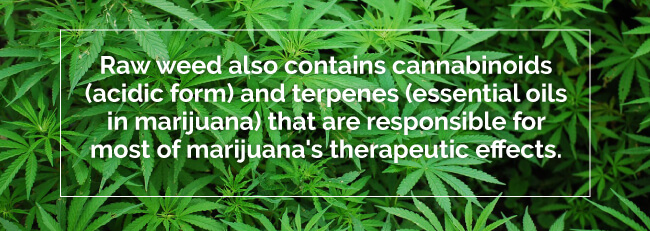
Along with its nutritional value, raw weed also contains cannabinoids (acidic form) and terpenes (essential oils in marijuana) that are responsible for most of marijuana’s therapeutic effects. And, since marijuana contains high cannabinoid acid concentrations, it’s considered to be an exceptional plant in the nutrition world, with its acids being essential for basic cell function.
Raw marijuana juice activates the endocannabinoid receptors of your brain and prompts an antioxidant release that removes damaged cells from your body. Both humans and animals have an endocannabinoid (EC) system that manages a broad range of physiological processes, such as pain sensation, memory, appetite and mood.
The EC receptors are located in your connective tissue, brain, glands, organs and immune cells in your body. Your body produces endocannabinoids naturally to stimulate all those functions. However, cannabis also stimulates your EC receptors and boosts your well-being.
According to studies, raw weed has the potential to:
The U.S. federal government found in its pre-patent research that CBD was a stronger antioxidant than vitamins C or E. Since you’re able to consume CBDs in large amounts when eating raw pot, you’re also increasing the number of antioxidants you’re getting per serving.

The terpenes are thought to have their health benefits as well. For instance, linalool is said to have anticonvulsant, anti-inflammatory and analgesic properties.
Raw cannabis has two primary cannabinoids: tetrahydrocannabinolic acid (THCA) and Cannabidiolic acid (CBDA). The “a” represents that they’re non-psychoactive, acidic form. Your body can metabolize THCA in larger doses than THC since it’s non-psychoactive. Therefore, if you’re looking for the medicinal benefits of marijuana but don’t want to get “high,” THCA is a better option.
There hasn’t been enough research conducted on THCA to positively state how effective it is and what it treats, though. However, preliminary research is suggesting that as the industry evolves, THCA will become a big part of marijuana medicine.
The main difference between THC and THCA is that when the pot plant is growing, it isn’t psychoactive. The THC psychoactive chemical isn’t present as of yet. It’s only in its elemental or decarboxylated form (THCA). You wouldn’t receive any effect from the fresh buds of the plant. You first need to convert the THCA into THC to get the psychosomatic effect you get with marijuana.
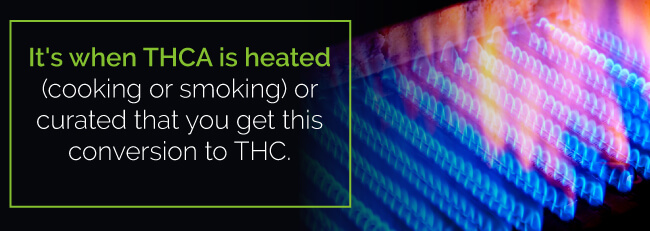
It’s when THCA is heated (cooking or smoking) or curated that you get this conversion to THC. If you were to eat the plant raw, you wouldn’t get the THC. Digested weed needs to enter your bloodstream to give you that “high” feeling. Since it’s difficult for your body to break down the composition of weed, it doesn’t absorb the chemical. It just passes through your digestive tract instead.
If your body is compromised by cellular dysfunction, autoimmune disorders, cancer cells, chronic inflammation or other illnesses, consuming CBDs provides an array of health benefits. One way to get your CBDs is by juicing the buds and leaves of raw cannabis. Mix the juice of cannabis with other things such as fruits, vegetables and juice to create a healthy drink.
Because of its health benefits, juicing raw cannabis is gaining a lot of attention. Marijuana isn’t just for eating or smoking. You can now drink it as well. And, when you juice it, you’re getting a lot more of its health benefits than if you were to eat or smoke it.
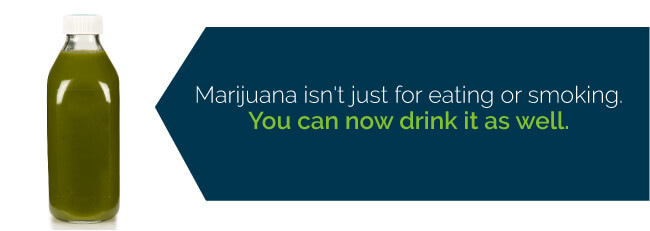
In fact, you’re losing around 99 percent of the health benefits of marijuana when you smoke or cook it.
Many health enthusiasts and dieters have been juicing their vegetables. Juicing creates a beverage that’s rich in nutrients and easy to consume and digest. It’s convenient if you have a busy schedule, too, since it’s simple to make it and take it with you.
When you juice raw weed, you’re getting large doses of THCA and CBDA. These two cannabinoids help saturate your CB1 and CB2 receptors with cannabinoids, which benefit the natural endocannabinoid system of your body. This produces an effective two-way communication system between your cells and nerves which was not present previously. Patients with everything from nerve disorders to diabetes realize the power behind juicing raw weed.
Dr. Courtney claims that juicing marijuana, a potent vegetable, is the most beneficial and healthiest ways to consume the plant. He says that many of the disorders you treat with marijuana, you can prevent by consuming raw marijuana juice regularly, and about 8,000 of his patients drink raw marijuana juice.
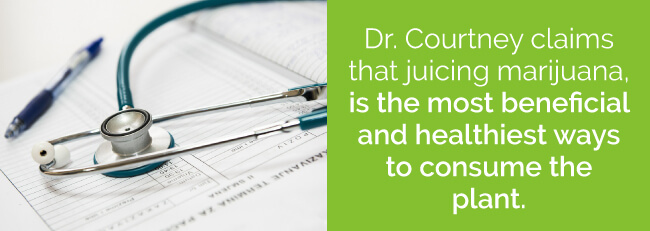
In addition to being rich in the same nutrients (iron, fiber, calcium) as leafy greens, it’s also loaded with beneficial cannabinoids exclusive to the weed plant, and juicing cannabis is an extremely potent and nutritionally-dense medicine. Ingesting raw marijuana through juicing may be beneficial for alleviating the symptoms of certain conditions, such as rheumatoid arthritis, as well as for for general health maintenance.
NYC Surgical Associates’ co-founder and managing director and double-board certified surgeon, Dr. David A. Greuner, said that you get the same therapeutic effects juicing raw cannabis for certain conditions as you do by smoking medical cannabis. For instance, studies show that cancer patients find relief from nausea and pain with juiced cannabis while it helps HIV patients who have difficulty eating.
Other benefits of juicing cannabis include:
Although many people might consider having no psychoactive effects a disadvantage, there are some individuals who want the health benefits of marijuana but don’t want to get high. Since you need heat to convert the THCA into THC (psychoactive form), you still get the raw cannabis juicing health benefits but without feeling stoned.
Like vaporizing, juicing marijuana allows people to enjoy the benefits without being exposed to the effects of smoking it. Smoking weed can lead to discomfort in your lungs’ air passages, which can result in chronic bronchitis and other respiratory disorders.
Cannabis is often used to treat certain chronic conditions. The easiest way to add it to your diet to keep you healthy and prevent various diseases is to juice it. The cannabinoids in cannabis, as mentioned, contain high amounts of anti-inflammatory and antioxidants, making it an excellent supplement to help prevent certain diseases including:

Marijuana’s rich antioxidants help your body to fight off free radicals. Juicing raw marijuana is best since smoking it reduces the potency of the antioxidants.
A study showed that cannabis helps treat obesity and other risk factors that are cardiometabolic related.
Another study published in the Journal of Brain Research suggested an increase of cannabinoid receptor activity in your body with raw cannabis that helps induce sleep without the THC effects.
The above isn’t an exhaustive list of all health benefits of raw marijuana, of course. Researchers believe that consuming raw weed (like juicing) can positively impact nearly all your body’s systems. And, as research on marijuana in its natural form is more widely allowed, many more benefits will show themselves.
Keep in mind that juicing raw cannabis isn’t necessarily for acute symptom relief, although some people may find immediate results. It may take you up to three days to appreciate benefits. However, sometimes it can also take longer for the effects to build, so it may take even more along the lines of four to eight weeks for you to realize the benefits.
You can enjoy all the benefits of raw cannabis by consuming it in its natural form. The best way of using this plant for its nutrients is by extracting the juice. However, you can also chew and swallow fresh, recently harvested cannabis leaves and buds, too.
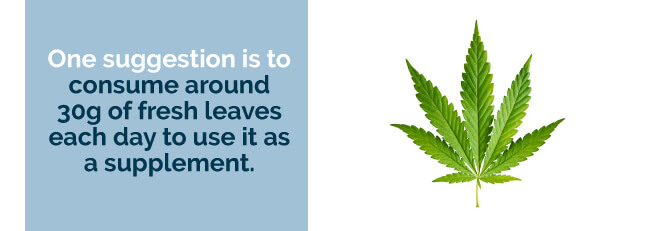
One suggestion is to consume around 30g of fresh leaves each day to use it as a supplement. You can also consume the oil from hemp seeds each day, toss sprouted cannabis seeds into your salads or divide 120 to 240 ml of raw cannabis juice into five doses.
Other tips when juicing raw cannabis are:
To extend the freshness of raw cannabis before blending, store it (un-rinsed) in the freezer or refrigerator in freezer bags. Before juicing, rinse well and soak the leaves in cool water for five minutes.
If you’re thinking about juicing marijuana yourself at home, there are some things you should keep in mind. You don’t want to use dried weed. It won’t work. You have to have fresh, recently harvested cannabis you either grow yourself or get from your dispensary. Ask your local dispensary for recommendations.
Here’s how to juice your raw cannabis:
The fresher the better, since vegetables break down soon after they’re harvested and lose their valuable enzymes. Your vegetables and cannabis need to be fresh to reap maximum benefits of your marijuana smoothie. If allowed by your state, an indoor closet or outdoor greenhouse works great to allow you to get enough marijuana for juicing regularly.
Use a strain with a cannabinoid profile that’s effective as a treatment for your specific ailment or symptoms. For instance, there are certain strains of cannabinoids that are effective for treating arthritis and seizures.
The cannabis plant provides essential cannabinoids that provide the most health benefits. These include THCA, THC, CBG, CBD, CBN, CBC. Excluding THC, these cannabinoids aren’t psychoactive and provide relief without the “high.” Here’s a closer look:
It also promotes bone growth and is effective with or without other cannabinoids.
Remember, THC is the only cannabinoid that will get you “high,” which is why its use isn’t mentioned here. All the other cannabinoids will provide relief without the psychoactivity.
To make marijuana juice, just add in two, 2- to 4-inch buds and 15 large fan leaves into a juicer. You should see small, sticky crystals on the flowers (trichomes) that indicate the buds are ready to harvest. They’re amber colored. Avoid nuggets that have been cured already for smoking. These won’t work and will waste your pot.
Adding in other vegetables like cucumbers, carrots or sweet potatoes with five parts vegetable juice to one-part marijuana juice might cut down on the strong weed flavor. Once mixed, you can drink it immediately or store it for up to three days. Combining one part of cannabis juice to 10 parts of carrot juice can help to reduce the bitterness associated with raw cannabis.

There’s minimal risk to juicing marijuana. In fact, Dr. Courtney said that only one or two out of his 8,000 patients reported an allergic reaction to the raw leaves that touched their skin.
You should know that cannabis typically isn’t organic. In fact, growers often use insecticides, pesticides and other types of chemicals you don’t want to ingest. Be sure you clean your cannabis well before consuming, or try to find an organic variety. Some people have reported feeling ill after consuming raw weed due to the use of pesticides.
Users have also reported throat irritation due to the sharp hairs on cannabis. This isn’t a huge concern when juicing the plant, but it’s something to take into consideration if you wish to chew on a cannabis stem.
Additionally, like any other cultivated plant, raw marijuana may harbor an array of microbes, and some of them may be pathogenic. The risk of being exposed to pathogens from fresh, raw weed is small, but if you have a compromised immune system, you should be careful.
If you’re interested in juicing raw cannabis, you should first search for a medical marijuana dispensary or doctor, so it’s legal and prescribed.